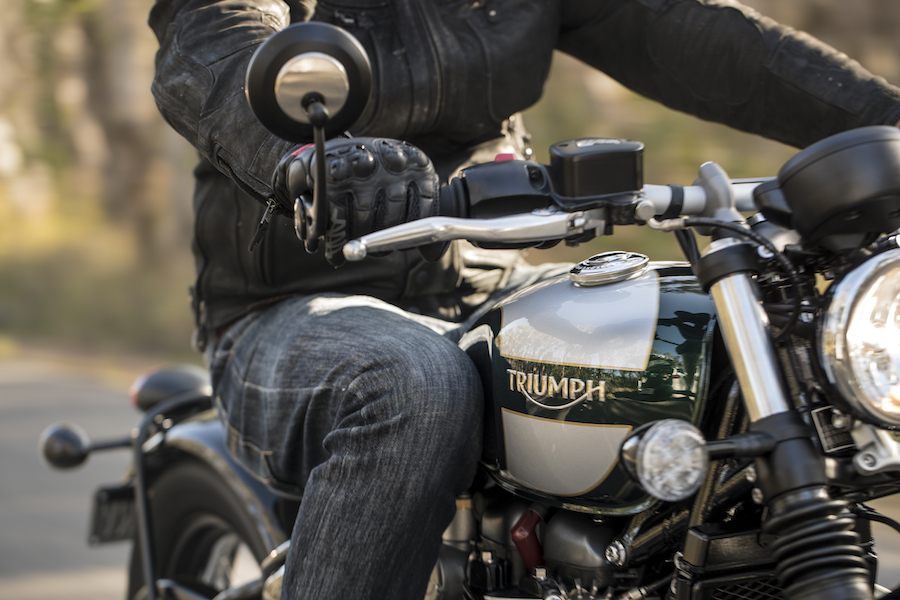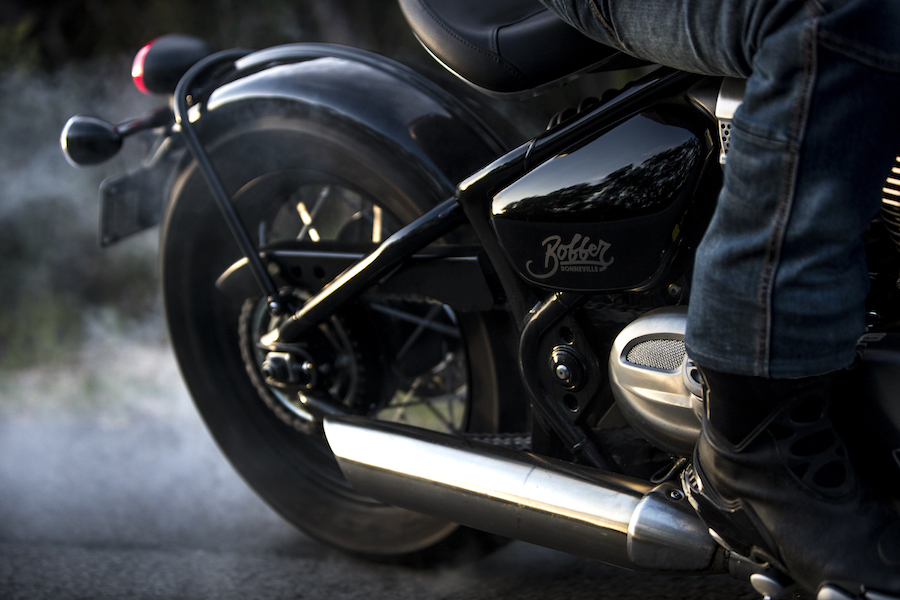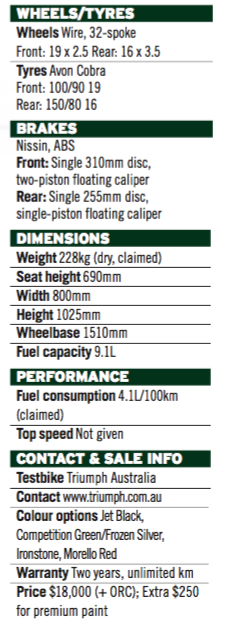Triumph’s supercool Bobber has sent customers racing to showrooms, but as Steve Martin finds out on his test fang, it’s much more than just a stylish moneymaker
Sometimes you need an alternative perspective to understand the true meaning of something that’s staring you in the face. As I sat on the plane heading to Noosa for the launch of the Triumph Bobber, I wasn’t sure what to make of this bike, or even how it would fit into the world of motorcycling as I knew it. I got chatting to the bloke next to me who wasn’t into bikes and hit him with my quandary. I pulled out a copy of AMCN and showed him a picture of a modern sportsbike, with all its bells and whistles, in action. Then I showed him one of the Bobber.
“The picture of the sportsbike goes up on the wall,” he said. “You know it’s fast and exciting; but the Bobber … now that’s a bike. It’s cool, angry, if it had two seats it’s the type of bike you could take to a club and not go home alone.” My eureka moment – the Bobber is about sex appeal.
I flicked back a few pages and stared at the Bobber for quite a while, trying to find something ugly, something distasteful, anything, but I failed. It’s low, it’s sleek, it’s minimalistic and as the twenty-something next to me on the plane said, it makes you feel good just looking at it.
The Bobber is an idea that had been on the table in Triumphs R&D department for quite some time, but they chose this year to release the machine to coincide with the new 900cc and 1200cc Bonneville twin engine platform.

These two new powerplants have been incorporated into 10 different models so far, and there is talk of more to come. That’s a good thing though as they have been a revelation, putting Triumph back on the map with new levels of sophistication, power and reliability, yet keeping the all-important retro feel alive and well.
The selling point of the Bobber, however, is its unique style and stance, something that I think the critics will have to agree with. It’s ready to go as a turnkey bling machine, and yet with over 150 accessories available you can individualise it to suit your own taste.
Looks-wise, Triumph is already on a winner. But the critical part about sticking to the Bobber theme in mass production must be making it user friendly on a day-to-day basis. All that great aesthetic work will be wasted if it’s not matched by the effort that goes into what’s underneath that pretty face.
Triumph’s designers and testers went into overdrive when making this bike comfortable and practical, something that doesn’t go hand in hand with the traditional custom bobber brief. The Trumpy’s physical size and shape throws up certain challenges that most other bikes can get away with. The first obstacle to overcome was the right rear-end look. The other retro bikes in Triumphs Bonneville line-up have a double-shock system, and that just wouldn’t look right this time around. A rigid rear was also ruled out for comfort reasons, so that left only one option: a mono. The designers somehow managed to hide a linkage-actuated rear monoshock system away from plain view and make it work well with 76.9mm of rear wheel travel.
In keeping with the clean visual theme, they then mounted a mudguard, lights, indicators and brake and wired it all up with sensors to make the traction control and ABS work while maintaining invisibility.
The laterally adjustable (35mm forward and back) seat unit then mounts from the rear of the main steel beam frame, gaining enough strength to support the rider and yet still maintain that floating look. The frame itself follows modern steering geometry and manufacturing standards, but is finished off like a custom-built bobber might have looked 60 years ago.
The fuel-injection system, ECU, battery and pretty much all the electronic wizardry needed to make this bike function is tucked neatly and tightly in one central location hidden between the twin air filter set-up. As on the Street Cup there is just the one butterfly unit feeding both cylinders, keeping the appearance narrow around the middle of the bike.
Even the cables and wiring heading up to the switchblocks are inconspicuous. It’s almost as if the whole design crew had OCD, and if they did I’m not sorry because in the case of this machine, less is definitely more.
The low-rider peanut-style tank is nice and slim, rounding out a slick package that can be adjusted to suit riders of all sizes. And the low seat height will allow even shorter riders to park or stop at the lights with confidence.
The Bobber also feels light on its feet, making getting on and off the bike easy, especially if you’re stiff in the legs. That low rear end means you don’t have to be able to do the high jump to get on board, which could see this machine extending the riding career of some of us who aren’t as flexible as when we were younger.
The heart of the Bobber is the Bonneville 1200cc HT (High Torque) liquid-cooled engine, like the one found in the T120. It shares the same DNA with its six-speed gearbox and single overhead cam, but some minor changes have been made to extract more torque and more bottom-end grunt. The days of chasing top-end power are over for the Hinckley-based company; instead the effort has gone in to finding power in that first twist of the wrist zone – what I like to call the real-world zone. The Bobber is very responsive in normal everyday use, and when you add the fact that you have two riding modes (road and rain) to play with, it’s easy to soften power delivery using rain mode even in the dry. The best part of having so much torque is that the slick gearbox doesn’t get used much. I found the best and most enjoyable way to ride the Bobber is to let it lug and keep changes to a minimum.
I would hate to be a test fleet bike. It’s a life of being ridden well beyond the normal everyday design parameters, abused and then judged. That’s what these bikes go through, but it’s the job of a good journo to probe and surpass those parameters. I certainly put this Bobber through its paces with an initial sedate run from Noosa along the David Low Way coast road and then through some traffic and roundabouts, lots of roundabouts. I think Noosa itself must be the roundabout capital of the world, but nevertheless it was a good test of stopping, starting and taking your eyes off the controls and seeing how they all fall back to hand. The general ergo layout is quite good, making this type of traffic situation fuss free.
Around town the Bobber was in its element and a hell of a lot more comfortable than I envisaged based on its extreme look. The seat is comfortable, as are the mid-mounted ’pegs that happily sit in the right natural position for my feet. I was dreaming away and just enjoying the ride, and though it may look tough, it’s not tough to ride. At one point – for the first time in my life – I started thinking that a pair of ape hangers might just improve the ride position. Could this be a bike to convert me to the cruiser side?

Whenever the wheels started to turn, all of Triumph’s hidden technology kicked in, making it a very easy and confidence-inspiring machine. Even with relatively little suspension travel the ride was very smooth in that real-world urban environment – equally as good as other retro cruisers I’ve ridden, even those with longer travel suspension.
As we left suburbia we headed out on to the Sunshine Motorway, which allowed us a bit of cruising time. Once again the Bobber provided surprising comfort for a machine of this style on the open road. Sixth gear feels like a definite overdrive, and at 100km/h the revs are a paltry 2650rpm. There’s no need to change down if you want to overtake either, as there’s plenty of oomph on hand.
Eventually it was time to get serious. We rode out of Bobber territory and hit the twisties, which turned out to be a mixture of smooth and rough roads. The general handling on a rough twisty road was well above what a machine with a brief like this should be capable of. Although it’s a completely different design to Triumph’s normal retro style, it was comforting to know that the same values of real-road performance were adhered to in making this radical bike. We were pushing hard and getting a bit of a move on, pushing the grip levels of the specifically designed Avon Cobra tyres to their limits. The tyres have a great amount of feel and grip, which made it easy for me to trust them – a great positive for any bike.
By now the Bobber was in unknown territory, riding outside its design parameters, and yet it coped. Yes, the ’pegs scraped and yes, on rough roads at high speed the suspension does bottom out with monster bumps, but one thing it never does is lose its composure. It doesn’t turn as tight as its twin brother the Street Cup either, but that’s not what this bike is about. The fact that it handled the foreign situation at all just adds another dimension to the Bobber that is an unexpected positive.
Riding sedately on those same twisty roads I never had a comfort issue. In fact, at those speeds the bike once again started to make me relax, enjoy and take in the scenery. The simplistic dash design makes reading it a breeze, and although there is a lot of information at hand to digest, it’s all adjusted by one information button which is easy to find on the left-hand switchblock.
When we got back after a day in the saddle I was impressed – I didn’t think I’d enjoy the Bobber revolution as much as I did. Once again, that’s down to this bike living up to its main design brief and then delivering on so many more fronts.
It’s getting harder and harder to find faults with any of the modern beasts now, and there is certainly nothing notably wrong with Triumph’s new twin. It might not go as far on a tank of gas as a tourer, and it might not be as comfortable as an adventure bike on a bumpy road, but just for the raw joy this machine gives you I reckon it doesn’t matter.
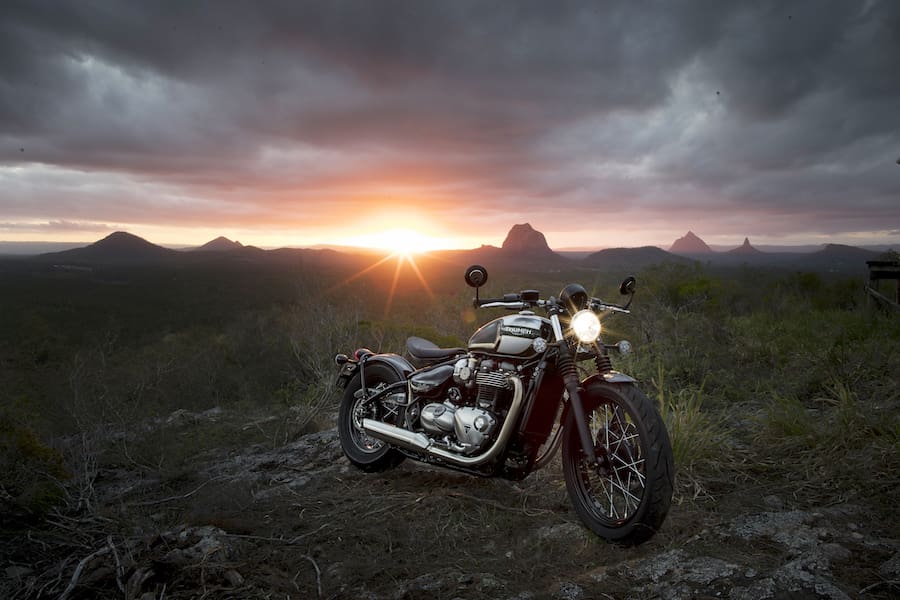
What makes a bobber?
Peanut tank
Sits low to the backbone of the bike, accentuating the sleek profile and keeping
it narrow at the rider’s knees.
Rigid rear end
Trickery is used in the modern Triumph Bobber, but its cage-style suspended rigid-looking rear end is in keeping with the original concept.
Bars
There are no rules on the bobber ’bars. Anything from clip-ons to ape hangers will do, and will be available as genuine accessories.
Controls
Clean looking with all the excess stripped away leaving just a single instrument dial, which can be adjusted for viewing angle.
Wheels
Spoked wheels with authentic scalloped hubs reinforce that forties look, but thankfully the Avon Cobra tyres that have been designed especially for Triumph have modern grip.
Single seat
Although Triumph says there are no plans for a pillion seat kit initially, there are some telltale mounting points near the swingarm pivot that might prove otherwise.
Exhaust
Slash-cut exhausts are a must. Thankfully the new bike has precision-made items – unlike the hacksawed original bobbers of a bygone era.
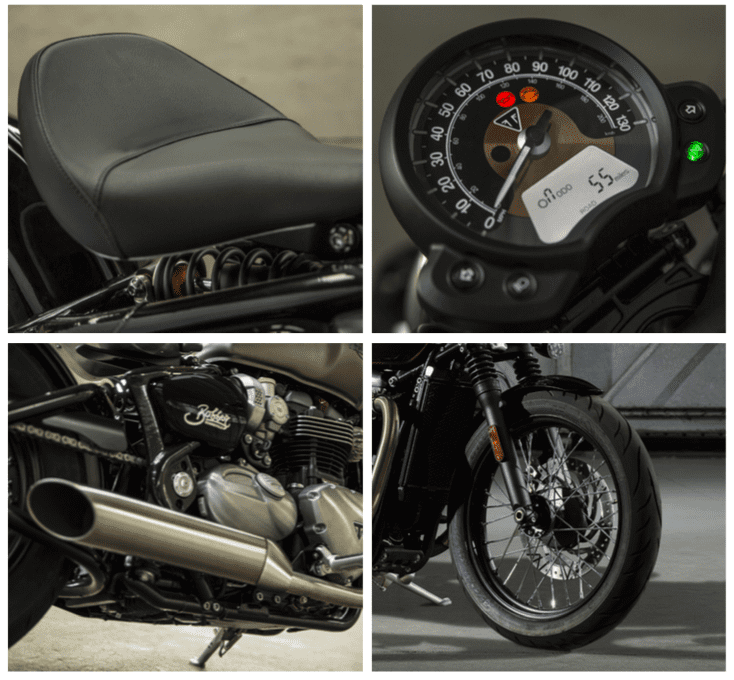
TEST STEVE MARTIN
PHOTOGRAPHY TRIUMPH AUSTRALIA
